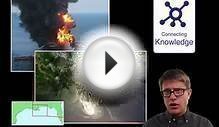
Environmental Science is a required badge to qualify for Eagle Scout.
Requirement 1[edit]
Make a timeline of the history of environmental science in America. Identify the contribution made by the Boy Scouts of America to environmental science. Include dates, names of people or organizations, and important events.Requirement 2[edit]
Define the following terms and describe the relationships among them: population, community, ecosystem, biosphere, symbiosis, niche, habitat, conservation, threatened species, endangered species, extinction, pollution prevention, brownfield, ozone, watershed, airshed, nonpoint source, hybrid vehicle, fuel cell. .- An ecosystem is a community of organisms (plant, animal and other living organisms - also referred as biocenose) together with their environment (or biotope), functioning as a unit.
- Conservation is an ethic of resource use, allocation, exploitation, and protection. Its primary focus is upon maintaining the health of the natural world: its forests, fisheries, habitats, and biological diversity. Secondary focus is on materials conservation and energy conservation, which are seen as important to protect the natural world.
- Ozone is an allotrope of oxygen that is much less stable than the diatomic O2. Ground-level ozone is an air pollutant with harmful effects on the respiratory systems of animals. The ozone layer in the upper atmosphere filters potentially damaging ultraviolet light from reaching the Earth's surface.
- A fuel cell is an electrochemical conversion device. It produces electricity from fuel (on the anode side) and an oxidant (on the cathode side), which react in the presence of an electrolyte.
Requirement 3[edit]
Do ONE activity in EACH of the following categories (using the activities in this {the merit badge} pamphlet as the basis for planning and carrying out your projects):
A. Ecology
- Conduct an experiment to find out how living things respond to changes in their environments. Discuss your observations with your counselor.
- Conduct an experiment illustrating the greenhouse effect. Keep a journal of your data and observations. Discuss your conclusions with your counselor.
- Discuss what is an ecosystem. Tell how it is maintained in nature and how it survives.
B. Air Pollution
- Perform an experiment to test for particulates that contribute to air pollution. Discuss your findings with your counselor.
- Record the trips taken, mileage, and fuel consumption of a family car for seven days, and calculate how many miles per gallon the car gets. Determine whether any trips could have been combined ("chained") rather than taken out and back. Using the idea of trip chaining, determine how many miles and gallons of gas could have been saved in those seven days.
- Explain what is acid rain. In your explanation, tell how it affects plants and the environment and the steps society can take to help reduce its effects.
C. Water Pollution
- Conduct an experiment to show how living things react to thermal pollution. Discuss your observations with your counselor.
- Conduct an experiment to identify the methods that could be used to mediate (reduce) the effects of an oil spill on waterfowl. Discuss your results with your counselor.
- Describe the impact of a waterborne pollutant on an aquatic community. Write a 100-word report on how that pollutant affected aquatic fife and what the effect was.
D.
Source: en.wikibooks.org
RELATED VIDEO

PCS EdventuresLab Merit Badge System

Environmental Science

 The University of Cambridge (informally known as Cambridge University or Cambridge) is a public research university located in Cambridge, United Kingdom. It is the second-oldest university in the English-speaking world (after the University of Oxford), and the...
The University of Cambridge (informally known as Cambridge University or Cambridge) is a public research university located in Cambridge, United Kingdom. It is the second-oldest university in the English-speaking world (after the University of Oxford), and the...








